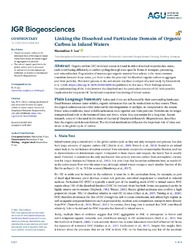Linking the Dissolved and Particulate Domain of Organic Carbon in Inland Waters
DOI: https://doi.org/10.1029/2021JG006266
Persistent URL: http://resolver.sub.uni-goettingen.de/purl?gldocs-11858/9572
Persistent URL: http://resolver.sub.uni-goettingen.de/purl?gldocs-11858/9572
Lau, Maximilian P., 2021: Linking the Dissolved and Particulate Domain of Organic Carbon in Inland Waters. In: Journal of Geophysical Research: Biogeosciences, Band 126, 5, DOI: 10.1029/2021JG006266.
 |
Dokument öffnen: |
Organic carbon (OC) in inland waters is found in either dissolved or particulate states, each contributing differently to carbon cycling through state‐specific forms of transport, processing, and mineralization. Degradation of macroscopic organic material into solutes is the most common transition between these states, yet there is also the potential for dissolved organic carbon to aggregate and form particles. This latter process at the soil‐stream interface is subject of a new study by Einarsdóttir et al. (2020, https://doi.org/10.1029/2020JG005654) published in this issue. Their findings advance the understanding of the links between the dissolved and the particulate domain of OC with possible implication for long‐term OC burial and ecosystem functioning of inland waters. Plain Language Summary:
Lakes and rivers are influenced by their surrounding landscape: Dead biomass releases water‐soluble, organic substances that can be washed into surface waters. There, the organic substances are either removed by microorganisms or sunlight, or transported to the oceans. Under some conditions, water‐soluble substances stick together and form particles. Particles are no longer transported and sink to the bottom of lakes and rivers, where they can remain for a long time. Recent research, some of it featured in this issue of Journal of Geophysical Research: Biogeosciences, describes how the organic particles are formed. The involved mechanisms influence the important role of lakes and rivers in the global cycle of carbon. Key Points:
Dissolved organic carbon is the dominant form of biomass in inland waters but various processes trigger its aggregation to particles.
The role of organic particles in the global carbon cycle is discussed in context of a recent manuscript published in Journal of Geophysical Research: Biogeosciences.
Statistik:
ZugriffsstatistikSammlung:
This is an open access article under the terms of the Creative Commons Attribution‐NonCommercial License, which permits use, distribution and reproduction in any medium, provided the original work is properly cited and is not used for commercial purposes.

